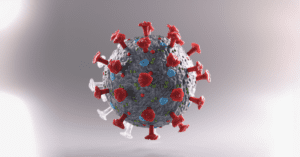
Written by Rana Abdelhalim
Edited by Dr. Spyros Petrakis
Early BDNF delivery improved cognitive and motor deficits while ameliorating cerebellar pathology in a SCA1 mouse model.
Cognitive impairment, slurred speech, difficulty with balance and walking— these are all symptoms of spinocerebellar ataxia type 1 (SCA1). SCA1 is an inherited neurodegenerative disorder caused by a polyglutamine repeat expansion in the ATXN1 gene. Individuals with SCA1 likely have pathology in the cerebellum, cortex, medulla, and hippocampus. Neuropathology studies have revealed cerebellar and brainstem atrophy, Purkinje cell depletion, and loss of neurons in the dentate gyrus of the hippocampus. Currently, there is no cure or treatment to slow the progression of this devastating disease.
Over the last two decades, brain-derived neurotrophic factor (BDNF) has been identified as a key factor for cognitive and motor functioning. BDNF has been shown to support the structural and functional integrity of the cerebellum as well as to regulate the formation of new brain cells in the hippocampus during development. Low BDNF levels in the brain have been associated with other neurodegenerative conditions that affect motor and cognitive ability, such as Alzheimer’s and Parkinson’s disease.
Due to BDNF’s critical role in brain function and its implication in other neurodegenerative conditions, a research group from the University of Minnesota further explored the role of BDNF in the SCA1 brain and assessed its therapeutic potential. To do so, the researchers asked three main questions:
- Are BDNF levels altered in the brain of SCA1 patients?
- How do BDNF levels change at different disease stages?
- Can BDNF be used as a treatment in a mouse model of SCA1?
To answer the first question, researchers used donated brains from SCA1 patients and healthy participants. Then, they explored differences in BDNF protein levels between the two groups. They found that BDNF levels were significantly reduced in the cerebellum and medulla of SCA1 patients compared to healthy individuals.
Next, researchers explored whether Bdnf mRNA levels change as the disease progresses. To answer this question, they used a mouse model of SCA1 and measured Bdnf levels in the cerebellum, hippocampus, cortex, and medulla of the brainstem at an early and late disease stage. Measurements were made using quantitative RT-PCR at the early stage and RNA sequencing at the late stage.
At the early stage of the disease, SCA1 mice had significantly lower Bdnf mRNA levels in the cerebellum and hippocampus, and significantly higher expression levels in the medulla and cortex compared to control mice. However, at the late disease stage, SCA1 mice had significantly lower Bdnf levels in the cortex, cerebellum, and hippocampus compared to control animals, while no significant difference in expression was found in the medulla. These findings illustrate that Bdnf levels may vary in the different brain regions and may change over time as the disease progresses. They also suggest that BDNF potentially plays different and region-specific roles during the different stages of SCA1.
Lastly, the authors were interested in investigating whether BDNF delivery in the brains of SCA1 mice has a therapeutic potential. To this end, they used an osmotic pump to deliver either BDNF or artificial cerebrospinal fluid (aCSF) directly to the brain at a constant rate. Treatment began at disease onset and continued for four weeks. Researchers found that SCA1 mice treated with BDNF had reduced cerebellar atrophy compared to those treated with aCSF and had similar Purkinje cell numbers as control mice. Moreover, they found that BDNF treatment rescued the proliferation of neurons in the dentate gyrus of the hippocampus.
To fully investigate BDNF’s therapeutic potential, researchers examined its effect on motor and cognitive symptoms using the rotarod and Barnes maze tasks. The rotarod assay assesses motor coordination and balance by placing mice on a rotating horizontal rod and recording the time needed for the animal to fall off the rod. BDNF-treated SCA1 mice stayed longer on the rotarod without falling off compared to those treated with aCSF.
In addition, the Barnes maze was used to measure the cognitive abilities of SCA1 mice. This assay consists of a circular platform with holes placed around the perimeter; an escape tunnel lies under one of these holes. The researcher assesses the strategies that the mice use to find the escape tunnel, with mice using more spatial strategies receiving a higher cognitive score. SCA1 mice treated with BDNF had significantly higher cognitive scores compared to those administered with aCSF.
Altogether, these findings show that BDNF treatment is not only capable of ameliorating cerebellar and hippocampal pathology, but it may also mitigate motor and cognitive deficits in SCA1 mice.
Overall, the findings of this study illustrate the important role that BDNF plays in the pathology and progression of SCA1 and reveal its therapeutic potential. Most intriguingly, their results suggest spatial and temporal differences in SCA1 pathology, as indicated by differing BDNF levels in various brain regions.
Despite these differences, BDNF treatment seems to be beneficial and has great translational potential, as also envisaged in the first human clinical trials aiming to assess the neuroprotective effect of BDNF in Alzheimer’s disease and mild cognitive impairment. BDNF plays many roles in healthy brain function and has been also implicated in the pathology of other neurodegenerative diseases. Therefore, the findings of this study may advance our understanding of other similar conditions, as well.
Key Words
Cerebrospinal Fluid (CSF): a clear, colourless fluid that cushions the brain and spinal cord by circulating between layers of tissues surrounding them. CSF provides the central nervous system with necessary nutrients and hormones while carrying away waste products.
Brain-Derived Neurotrophic Factor (BDNF): A protein produced in the brain that supports the growth, survival, and maturation of neurons. Decreased levels of BDNF have been seen in multiple types of neurodegenerative diseases.
Mouse Model: A type of animal model with specific characteristics that allow for the study of various aspects of a human disease/condition.
Messenger RNA (mRNA): the RNA molecules that ‘translate’ the genetic code from DNA so that proteins can be built based on that code.
Conflict of Interest Statement
The author and editor have no conflicts of interest to declare.
Citation of Article Reviewed
Rosa, J.G., et al., BDNF is altered in a brain-region specific manner and rescues deficits in Spinocerebellar Ataxia Type 1. Neurobiology of disease, 2023. 106023(178): p. 1-11. (https://pubmed.ncbi.nlm.nih.gov/36724861/)
Read Other SCAsource Summary Articles

Los científicos desarrollan un nuevo enfoque para evaluar la Ataxia en casa
Escrito por Ziyang Zhao Editador por la Dra. Hayley McLoughlin Traducido por Ismael Araujo Aliaga Una aplicación para teléfonos inteligentes recientemente desarrollada permitirá a los pacientes evaluar la ataxia en casa. Existe Read More…

The SCA2 Chronicles: Unmasking COVID-19’s impact on Mind and Movement in a Galaxy Not So Far Away
Written by Kaitlyn Neuman Edited by Celeste Suart, PhD Lessons from a global pandemic: COVID-19 negatively impacts speech function and mental health in SCA2 patients. A short time ago, in a Read More…

Online Speech Therapy program helps improve speech in ataxia
Written by Caroline Spencer, PhD Edited by Celeste Suart, PhD ClearSpeechTogether is a virtual group-based speech therapy program for people with speech problems due to progressive ataxia. In this article, researchers Read More…










